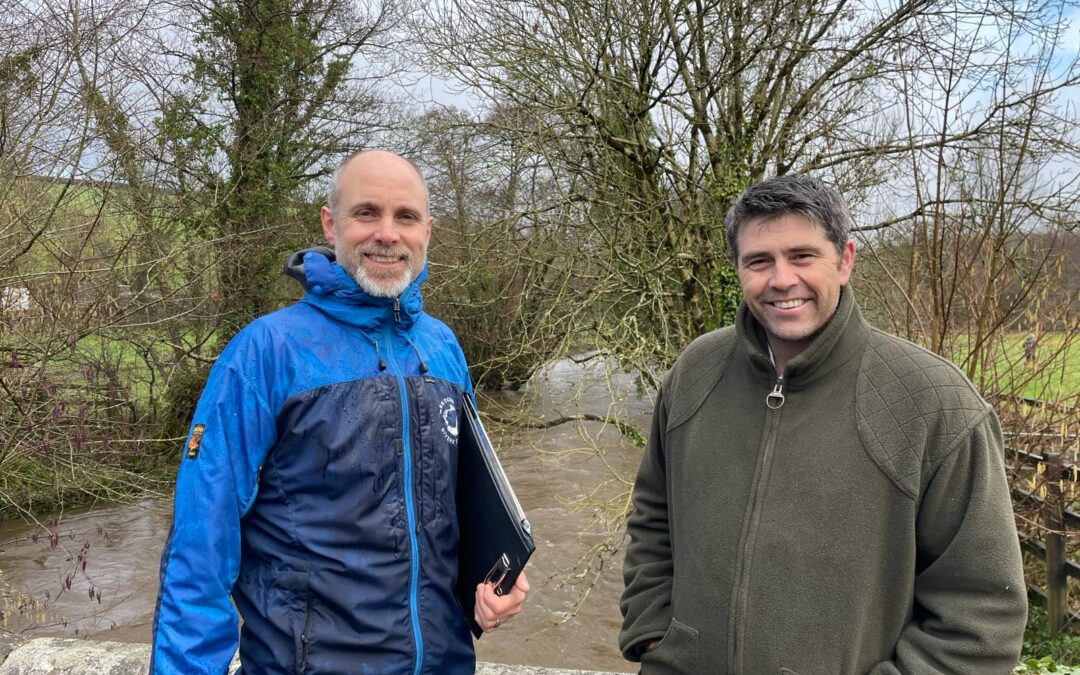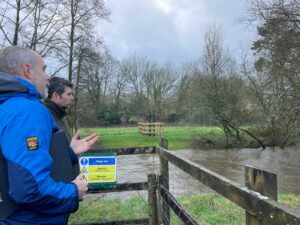In November 2023, we took part in a BBC interview regarding pollution of the River Inny.
Our CEO Dr Laurence Couldrick spoke about the issues facing this river, the wider catchment and freshwater environments.
“The scale of water quality and wider water-related issues is a huge and complex problem.
“We need to dig into the detail to look at the catchment story; it has been made more challenging as the Environment Agency (EA) do not monitor as many sites as they used to so society is filling some of the gaps such as through citizen science data or angling reports.”
MP for North Cornwall Scott Mann contacted us in February 2024 to join him on a visit to the area after concerns about the river’s health and the local sewerage system were brought to his attention following the interview’s airing.
Mr Mann said: “I attended a site at Bealsmill to hear more about water quality in the River Inny after Lezant Parish Council contacted me.
“I am very grateful for the full briefing on the situation from Westcountry Rivers Trust’s CEO Dr Laurence Couldrick.
“I will be contacting South West Water to discuss my findings and demand answers.”
Laurence shared several river-related issues facing myriad freshwater environments with the MP, and added: “It is essential our rivers are afforded the support they need – without them our lives will be very different.”
Overarching issues
Pollution is coming from various sources and the exact proportion varies from river to river but the major contributors are:
•
Sewage
Combined Sewage Overflows are one of the few elements measured. They have been used outside of their expected operating design (e.g., in storm conditions) so the impact is much greater at these times but also a bit of a red herring as the monitoring doesn’t record volume and loading. Constant discharges from treated waste water usually represent higher total loadings and often include several worrying merging pollutants. Housing more generally has an impact, as does private sewage and drainage.
•
Agriculture
Farming is hugely impactful and operates at a considerable scale with 70-80% of the catchments farmed. The minimal historic presence of the EA, together with the push for cheap food, has meant there has not been the investment needed and pressure required to reach an adequate baseline. Enforcement is improving but is funded through work arounds such as the Regional Flood and Coastal Committee funding EA Land Management Officers. Laurence added: “The new Farm Subsidy Scheme will help but is a sticking plaster on a complex and multifaceted issue. A national land use plan is needed to help direct funding and highlight to farmers what we need and where.”
•
Industry
Other industries impact the river. For example, on the River Inny, Saputo (Dairy Crest) was fined £1.5m fine for phosphate pollution from the Davidstow plant. Some of these issues have been resolved but there are still under investigation by the EA about other impacts.
•
Roads
Little is done about the impact of oils, fuels, metals etc that come from vehicles when they wash off roads directly into rivers. Some of the major newer roads have wetland treatment but these are few and far between.
•
Mining
There is legacy input of metals from disused mines across the West Country. This includes arsenic, copper and tin, all adding to the river. The worrying element is we do not know how all of the above interact to cause secondary issues.
•
Flooding
Compacted land causes excess run-off. Over the years, efforts to speed conveyance out of our catchments has been made. When water runs off land it takes any pollutants with it so the majority of pollutant loadings happen during this period. We can hold water back and slow flows but it requires investments in soils, Nature-based Solutions like wetlands and woodland, and payments to match. This allows us to protect towns and villages by turning a quick and dirty response to rainfall to a slow and clean flow.
•
Drought
The conveyance of water can mean it is not there for the summer. As the weather patterns shift we get dry periods and all too quickly we are in drought. This exacerbates point sources of pollution that don’t occur through flooding. The lack of water concentrates pollutants, and the high temperatures mean we get more algal blooms and toxic fish kills. Again, measures to slow and store water means we can use this water to offset mains water demand as well as release flows to the river at critical times.
•
Biodiversity
All the above means anything trying to live in the river is really impacted. Coupled with river corridor habitat decline and encroachment through weirs and in-river structures, we have seen huge reductions in aquatic species numbers and diversity.
What can we do?
We must gather more data through regulatory and citizen science opportunities and support more community storytelling to make our rivers relevant to everyday life.
In addition, we need more enforcement based on smart remote data should be initiated; more separation of surface water from the sewage system; and more funding for road and mine water interception and treatment should be provided.
Farmers should receive more integrated support to provide food alongside wetland buffers, soil management, hedgerow drainage, and water storage (ponds, lakes) options.


